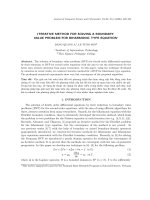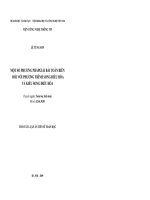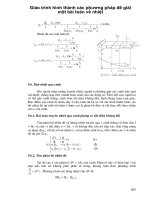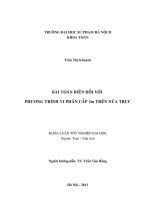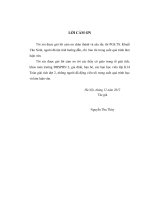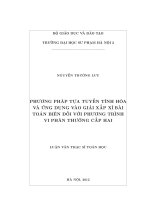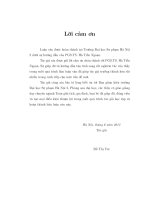Phương pháp lặp giải một bài toán biến đổi với phương trình kiểu song điều hòa. docx
Bạn đang xem bản rút gọn của tài liệu. Xem và tải ngay bản đầy đủ của tài liệu tại đây (121.68 KB, 6 trang )
Journal of Computer Science and Cybernetics, Vol.22, No.3 (2006), 229—234
ITERATIVE METHOD FOR SOLVING A BOUNDARY
VALUE PROBLEM FOR BIHARMONIC TYPE EQUATION
*
DANG QUANG A
1
, LE TUNG SON
2
1
Institute of Information Technology
2
Thai Nguyen Pedagogic College
Abstract. The solution of boundary value problems (BVP) for fourth order differential equations
by their reduction to BVP for second order equations with the aim to use the achievements for the
latter ones attracts attention from many researchers. In this paper, using the technique developed
by ourselves in recent works, we construct iterative method for a BVP for biharmonic type equation.
The performed numerical experiments show very fast convergence of the proposed algorithm.
T´om t˘a
´
t. Viˆe
.
c gia
’
i c´ac b`ai to´an biˆen
dˆo
´
i v´o
.
i phu
.
o
.
ng tr`ınh
da
.
o h`am riˆeng cˆa
´
p bˆo
´
n b˘a
`
ng c´ach du
.
a
ch´ung vˆe
`
c´ac b`ai to´an biˆen
dˆo
´
i v´o
.
i phu
.
o
.
ng tr`ınh cˆa
´
p hai
d˜a thu h´ut su
.
.
quan tˆam cu
’
a nhiˆe
`
u t´ac gia
’
.
Trong b`ai b´ao n`ay, su
.
’
du
.
ng k˜y thuˆa
.
t do ch´ung tˆoi ph´at triˆe
’
n trong nhi`eu cˆong tr`ınh m´o
.
i
dˆay, mˆo
.
t
phu
.
o
.
ng ph´ap l˘a
.
p gia
’
i mˆo
.
t b`ai to´an biˆen cho phu
.
o
.
ng tr`ınh song kiˆe
’
u
diˆe
`
u h`oa d˜a du
.
o
.
.
c
dˆe
`
xuˆa
´
t. Su
.
.
hˆo
.
i tu
.
nhanh cu
’
a phu
.
o
.
ng ph´ap
d˜a du
.
o
.
.
c ch´u
.
ng to
’
trˆen nhiˆe
`
u thu
.
.
c nghiˆe
.
m t´ınh to´an.
1. INTRODUCTION
The solution of fourth order differential equations by their reduction to boundary value
problems (BVP) for the second order equations, with the aim of using efficient algorithms for
these, attracts attention from many researchers. Namely, for the biharmonic equation with the
Dirichlet boundary condition, there is intensively developed the iterative method, which leads
the problem to two problems for the Poisson equation at each iteration (see e.g. [4, 9, 11, 12]).
Recently, Abramov and Ulijanova [1] proposed an iterative method for the Dirichlet problem
for the biharmonic type equation, but the convergence of the method is not proved. In
our previous works [6, 7] with the help of boundary or mixed boundary-domain operators
appropriately introduced, we constructed iterative methods for biharmonic and biharmonic
type equations associated with the Dirichlet boundary condition. Recently, in [8] for solving
the Neumann BVP we introduced a purely domain operator for studying the convergence of
an iterative method. It is proved that the methods are convergent with the rate of geometric
progression. In this paper we develop our technique in [4] - [8] for the following problem
Lu ≡ ∆
2
u − a∆u + bu = f
in
Ω, (1)
u = g
0
,
∂∆u
∂ν
= g
1
on
Γ, (2)
where
∆
is the Laplace operator,
Ω
is a bounded domain in
R
n
(n ≥ 2), Γ
is the sufficiently
∗
This work is supported in part by the National Basic Research Program in Natural Sciences, Vietnam
230
DANG QUANG A, LE TUNG SON
smooth boundary of
Ω
,
ν
is the outward normal to
Γ
and
a, b
are positive constants. The
equation (1) with other boundary conditions are met, for example, in [2, 3, 8]. An iterative
method reducing the problem to a sequence of Neumann and Dirichlet problems for second
order equations will be proposed and investigated by experimental way.
2. CONSTRUCTION OF ITERATIVE METHOD
Set
∆u = v
and
ϕ = −bu. (3)
Then the problem (1)—(2) is decomposed into the two problems
∆v − av = f + ϕ
in
Ω,
∂v
∂ν
= g
1
on
Γ. (4)
∆u = v
in
Ω, u = g
0
on
Γ. (5)
From here we see that the solution
u
of the above problems depends on the function
ϕ
, i.e.,
u = u(ϕ)
. Since
u
and
ϕ
are related with each other by the relattion
(3)
we get the functional
equation
ϕ + bu(ϕ) = 0. (6)
In order to construct iterative method for finding
ϕ
first we have to establish the concrete
form of the above equation. For the purpose we introduce an operator
B
defined in the space
L
2
(Ω)
by the formula
Bϕ = bu, (7)
where
u
is found from the problems
∆v − av = ϕ
in
Ω,
∂v
∂ν
= 0
on
Γ, (8)
∆u = v
in
Ω, u = 0
on
Γ. (9)
Proposition 2.1. The problem (4), (5) is reduced to the operator equation
(I + B)ϕ = F, (10)
where
F = −bu
2
, (11)
u
2
being found from the problem
∆v
2
− av
2
= f
in
Ω,
∂v
2
∂ν
= g
1
on
Γ, (12)
∆u
2
= v
2
in
Ω, u
2
= g
0
on
Γ. (13)
Proof. First we notice that the functions
u
2
and
v
2
are completely determined by the data
functions of the original problem (1), (2), namely, by
f
,
g
0
and
g
1
. Let
u
and
v
be the solutions
of the problems (4), (5). Put
u = u
1
+ u
2
, v = v
1
+ v
2
,
ITERATIVE METHOD FOR SOLVING A BOUNDARY VALUE PROBLEM
231
where
v
1
and
u
1
satisfy the problems
∆v
1
− av
1
= ϕ
in
Ω,
∂v
1
∂ν
= 0
on
Γ, (14)
∆u
1
= v
1
in
Ω, u
1
= 0
on
Γ. (15)
By the definition of
B
we have
Bϕ = bu
1
.
Taking into acount (6) from the above equality we obtain the equation (10) with
F
given by
(11). Thus, the proposition is proved.
Now, consider the following two-layer iterative scheme for solving the operator equation
(10)
ϕ
(k+1)
− ϕ
(k)
τ
+ (I + B)ϕ
(k)
= F, k = 0, 1, 2, (16)
where
τ
is an iterative parameter.
Proposition 2.2. The iterative scheme (16) can be realized by the following iterative process
1. Given
ϕ
(0)
∈ L
2
(Ω).
2. Knowing
ϕ
(k)
(x)
in
Ω (k = 0, 1, )
solve consecutively two problems
∆v
(k)
− av
(k)
= f + ϕ
(k)
in
Ω,
∂v
(k)
∂ν
= g
1
on
Γ,
(17)
∆u
(k)
= v
(k)
in
Ω,
u
(k)
= g
0
on
Γ.
(18)
3. Compute the new approximation
ϕ
(k+1)
= (1 − τ)ϕ
(k)
− τbu
(k)
. (19)
Proof. It is easy to verify that the solution
u
(k)
and
v
(k)
of the problems (15), (16) can be
represented in the form
u
(k)
= u
(k)
1
+ u
2
, v
(k)
= v
(k)
1
+ v
2
,
where
u
2
, v
2
are solutions of (12), (13) and
u
(k)
, v
(k)
satisfy (14), (15) with upper indexes
k
.
Therefore, according to the definition of
B
we have
Bϕ
(k)
= bu
(k)
1
,
and consequently,
bu
(k)
= Bϕ
(k)
− F.
In view of this, rewriting (19) in the form
ϕ
(k+1)
− ϕ
(k)
τ
+ ϕ
(k)
+ bu
(k)
= 0 (20)
232
DANG QUANG A, LE TUNG SON
we obtain the formula (16). Thus, the proposition is proved.
3. NUMERICAL RESULTS
As we see from the iterative process described in the Proposition 2.2 at each iteration
we have to solve two BVP for second order equations for
v
(k)
and
u
(k)
. For this purpose
we can use many available efficient algorithms. Here for definiteness we consider the original
problem in unit square and construct difference schemes of second order aproximation. Then
for solving the obtained systems of grid equations we use the method of complete reduction
[13] with computational complexity of
O(MNlog
2
N).
We perform some limited experiments in MATLAB for testing the convergence of the
iterative process (17)—(19) in dependence on iterative parameter
τ
and values of
a
and
b
. The
stopping criterion for the iterative process is
||ϕ
(k+1)
− ϕ
(k)
||
∞
< ε = h
1
h
2
, where
h
1
and
h
2
are grid stepsizes. In all examples below we take exact solutions
u
and the functions
f, g
0
, g
1
are calculated in accordance with the given exact solutions. The results of experiments for
τ = 1
are presented in tables, where
K
is the number of iterations,
Error = ||u − u
app
||
∞
,
u
app
is the computed approximate solution. The computations are carried out on PC Pentium
4 CPU 1.80 Ghz .
Table 1.
u = 0.25 x
4
+ 0.25 y
4
+ x
2
+ y
2
, a = 1, b = 1.5
Grid
h
1
*
h
2
K
Error Time (secs)
32 × 32
9.76
e − 4
4 2.80
e − 4
0.79
64 × 64
2.44
e − 4
4 8086
e − 5
2.04
128 × 128
6.10
e − 5
5 1.38
e − 5
9.70
256 × 256
1.52
e − 5
6 4.18
e − 6
68.20
Table 2.
u = sin(πx) sin(πy), a = 1, b = 1
Grid
h
1
*
h
2
K Error Time (secs)
32 × 32
9.76
e − 4
2 0.0014 0.66
64 × 64
2.44
e − 4
2 3.73
e − 4
1.62
128 × 128
6.10
e − 5
2 9.30
e − 5
6.12
256 × 256
1.52
e − 5
3 8.62
e − 7
43.07
Table 3.
u = (x
2
− 1)
2
e
y
+ (y
2
− 1)e
x
, a = 1, b = 1
Grid
h
1
*
h
2
K Error Time (secs)
32 × 32
9.76
e − 4
3 9.50
e − 4
0.73
64 × 64
2.44
e − 4
3 2.32
e − 4
1.79
128 × 128
6.10
e − 5
4 5.98
e − 5
8.81
256 × 256
1.52
e − 5
4 1.51
e − 5
55.59
From Tables 1—3 we see that the proposed iterative process (17)—(19) with the chosen
τ = 1
converges very fast. Some experiments with other values of
τ
require more iterations.
For the fixed
τ = 1
we also perform experiments for number of iterations in dependence
on
b
with fixed
a
and in dependence on
a
with fixed
b
. The results of the experiments in the
case of the exact solution
u = (x
2
− 1)
2
e
y
+ (y
2
− 1)e
x
, grid
128 × 128
are given in Tables 4, 5.
ITERATIVE METHOD FOR SOLVING A BOUNDARY VALUE PROBLEM
233
Table 4. Number of iterations
in dependence on
b
for fixed
a = 1
b
1 3 5 7 9 11 13 15 16
K
4 7 10 14 20 29 46 95 177
Table 5. Number of iterations
in dependence on
a
for fixed
b = 2
a
2 1 0.8 0.6 0.4 0.3 0.15 0.13 0.12
K
4 5 6 7 9 12 41 88 236
From Tables 4, 5 we see that the proposed iterative process (17)—(19) shows very good
convergence for the case
b/a 5
that is met in real plate bending problems.
4. CONCLUDING REMARK
In the paper an iterative method for solving the boundary value problem (1)—(2) for bi-
harmonic type equation was proposed. Its idea is to reduce the problem to a sequence of
Neumann and Dirichlet problems for second order equations. The fast convergence of the
method was shown on various experiments, where the value of iterative parameter
τ = 1
seems to be optimal. Theoretical proof of this convergence remains an open problem to be
studied.
REFERENCES
[1] A. A. Abramov and V. I. Ulijanova, On a method for solving biharmonic type equation
with singularly small parameter, Journal of Comput. Math. and Math. Physics 32 (1992)
567—575 (Russian).
[2] J. P. Aubin, Approximation of Elliptic Boundary-Value Problems, Wiley-Interscience,
1971.
[3] D. Begis, A. Perronet, The club modulef, Numerical Methods in Applied Mathematics,
Ed. G. Marchuc and J. L. Lions, Nauka, Novosibirsk, 1982, 212—236 (Russian).
[4] Dang Quang A, On an iterative method for solving a boundary value problem for fourth
order differential equation, Math. Physics and Nonlinear Mechanics 10 (1988) 54—59
(Russian).
[5] Dang Quang A, Approximate method for solving an elliptic problem with discontinuous
coefficients, Journal of Comput. and Appl. Math. 51 (1994) 193—203.
[6] Dang Quang A, Boundary operator method for approximate solution of biharmonic type
equation, Journal of Math. 22 (1 & 2) (1994) 114—120.
[7] Dang Quang A, Mixed boundary-domain operator in approximate solution of biharmonic
type equation, Vietnam Journal of Math. 26 (1998) 243—252.
[8] Dang Quang A, Iterative method for solving the Neumann boundary value problem for bi-
harmonic type equation, Journal of Computational and Applied Mathematics 196 (2006)
634—643.
234
DANG QUANG A, LE TUNG SON
[9] A. Dorodnisyn, N. Meller, On some approches to the solution of the stationary Navier—
Stoke equation, Journal of Comp. Math. and Math. Physics. 8 (1968) 393—402 (Russian).
[10] P. Gervasio, Homogeneous and heterogeneous domain decomposition methods for plate
bending problems, Comput. Methods Appl. Mech. Engrg. 194 (2005) 4321—4343.
[11] R. Glowinski, J L. Lions and R. Tremoliere, Analyse Numerique des Inequations Varia-
tionelles, Dunod, Paris, 1976.
[12] B. V. Palsev, On the expansion of the Dirichlet problem and a mixed problem for bihar-
monic equation into a seriaes of decomposed problems, Journal of Comput. Math. and
Math. Physics 6 (1) (1966) 43—51 (Russian).
[13] A. Samarskii and E. Nikolaev, Numerical Methods for Grid Equations, Vol. 2, Birkh¨auser,
Basel, 1989.
Received on March 17, 2006
Revised on July 30, 2006

